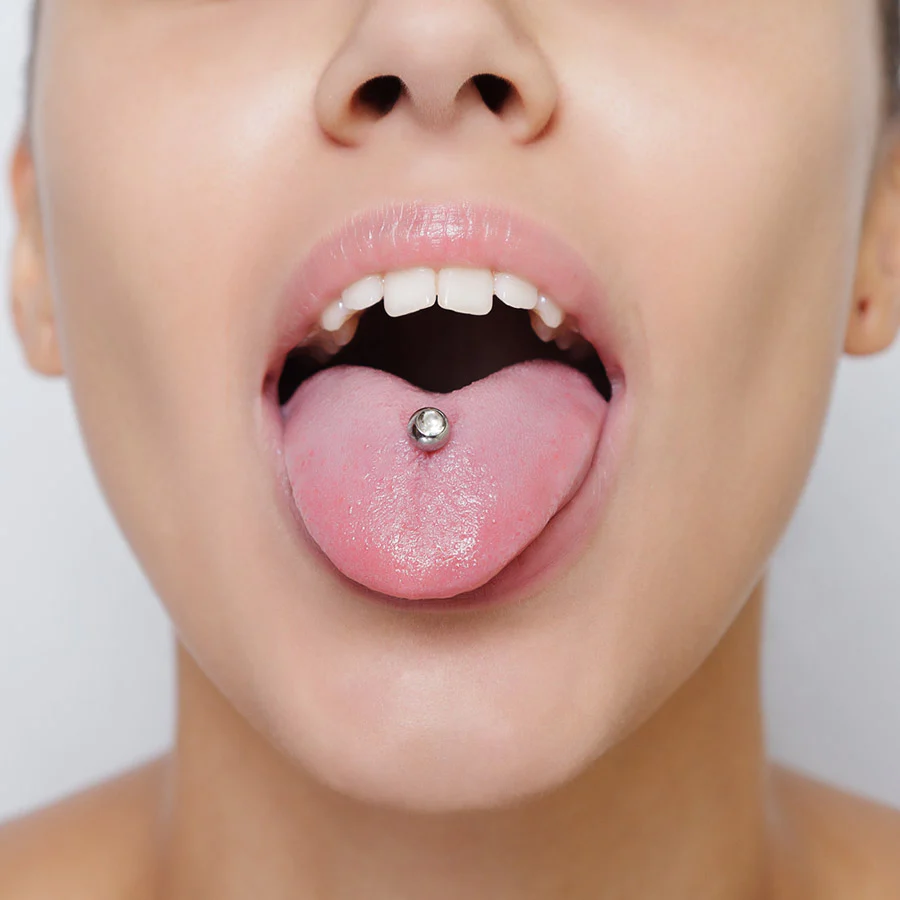Tongue piercings are a popular form of body art. They have been around for centuries and worn by different cultures worldwide. If you’re considering getting a tongue piercing, there are essential things you need to know before making the decision.
In this blog, we will cover everything from the history and cultural significance of tongue piercings to different types of tongue piercings and post-piercing care and maintenance. We will also answer common questions like, “Are tongue piercings dangerous?” and “Can anyone get a tongue piercing?”.
So, if you’re interested in getting a tongue piercing or just curious about it, keep reading!
Understanding Piercings on Tongue
Oral piercings involve piercing the tongue muscle. Healing takes 4-6 weeks, with varied aftercare needs. Risks include infection, pain, swelling, and possible damage to teeth and gums. Healing time varies, requiring essential oral hygiene. Different types of tongue piercings have distinct healing requirements. Proper care is crucial to avoid complications.

What are Piercings on Tongue?
A tongue piercing involves piercing the center of the tongue, typically with barbells or rings. It can affect oral health due to the presence of blood vessels and lingual arteries. The pain level and healing time vary, usually 4-6 weeks. Proper aftercare, like avoiding acidic and hot foods, is crucial for healing.
History and Cultural Significance of Tongue Piercings
Dating back centuries, tongue piercings hold historical and cultural significance in various cultures. They symbolize status, spirituality, or rites of passage in some societies. Today, they are popular as a form of self-expression and body jewelry. The meaning of tongue piercings differs across traditions, highlighting their diverse cultural significance and importance.
Different Types of Tongue Piercings
Midline tongue piercings involve a vertical piercing at the center of the tongue, while snake eye piercing creates a snake eye appearance at the tip. Venom piercing consists of double piercings on the top of the tongue, resembling snake fangs. Each type has its unique healing process, risks, and aftercare needs, requiring careful consideration before getting a new piercing.
Midline Tongue Piercing

Midline tongue piercing, a vertical piercing at the center of the tongue, typically heals in 4-6 weeks with proper aftercare. Risks include infection, swelling, and complications. Aftercare involves maintaining oral hygiene, avoiding oral health risks, and regular check-ups. Understanding the healing process is critical for a positive piercing experience. Incorporating new piercing jewelry is a good idea to avoid an open wound.
piercing tongue snake eyes

Snake eyes tongue piercing, a piercing on the tip of the tongue, creates a snake eyes appearance. Healing time varies, and proper aftercare is vital. Risks include tongue swelling, slight lisp, and oral health concerns. Good oral hygiene, avoiding acidic foods, and saline solution rinses are essential for aftercare. Understanding the healing process is crucial for risk management.
Venom Piercing

Resembling the fangs of a snake, venom piercing involves a double piercing on the top of the tongue. With a healing time of 4-6 weeks, proper aftercare is crucial to manage risks such as swelling and pain. Understanding the healing process is essential for mitigating complications, making proper oral hygiene and saline solution rinses imperative.
Things to Know Before Getting a Tongue Piercing

Before investing in a new piercing, consider potential risks like piercing tongue infection, swelling, and pain. To minimize these piercing risks, opt for professional piercers and high-quality jewelry and adhere to proper aftercare. Since pain levels and healing times vary, monitor oral hygiene and schedule regular check-ups. Understanding these factors is crucial before deciding to have a tongue piercing.
Potential Risks and Safety Measures
When considering new piercings, it’s essential to understand the potential piercing risks and safety measures involved. These may include piercing tongue infection, risk of gum recession, and possible complications. Choose a professional piercer to ensure safety, use high-quality jewelry, and follow proper aftercare. Understanding these aspects is essential to make an informed decision regarding tongue piercings.
Pain and Healing Time
Managing pain and healing time is crucial for new tongue piercings. The healing process typically lasts 4-6 weeks and requires proper aftercare. Risks such as pain, swelling, and complications necessitate attention to oral hygiene. Using saline solution rinse and good oral hygiene practices promotes healing. Understanding these aspects helps manage piercing risks and ensure a smooth healing process.
Costs Associated with Tongue Piercing
The expenses for a new piercing on the tongue vary based on the studio and jewelry selected. These typically encompass the piercing cost and the jewelry price. Additional fees may arise if complications occur, warranting medical attention. It’s advisable to research the average costs in your locality before proceeding with a tongue piercing and consider the long-term maintenance expenses.
The Piercing On Tongue Process

The piercing on tongue process process involves marking the site, cleaning, and using a clamp to hold the tongue. A professional piercer uses a hollow needle for the piercing, fitting it with the chosen jewelry. It’s quick, lasting minutes, and aftercare instructions are provided post-piercing.
Finding a Reputable Piercing Studio
When choosing a piercing studio, prioritize experienced piercers and proper hygiene. Check for the use of sterile, single-use needles and jewelry. Research online reviews and seek recommendations. Visit the studio in person to assess cleanliness and professionalism. A reputable studio will prioritize safety and aftercare, guiding you through the process.
What to Expect During the Piercing Process
Immediately after the piercing, a slight lisp or swelling may occur. Pain levels vary, but the process is swift. Some bleeding is normal, and proper oral hygiene guidance is provided. Expect temporary swelling post-piercing, subsiding within days. Before leaving the studio, understand infection signs and the healing process.
Post-Piercing Care and Maintenance

Following a new piercing, it’s a good idea to rinse the mouth with saline solution after meals and avoid acidic or hot foods. Maintaining good oral hygiene with alcohol-free mouth rins is crucial to prevent infections. Recognizing signs of infection and seeking professional help when needed is essential. Do not ignore any symptoms, and keep the area clean to aid healing.
Basic Aftercare Guidelines
After getting a new piercing, keeping the site clean using saline solution is a good idea. Refrain from touching the piercing with unwashed hands to avoid infection. Also, maintain proper oral health and follow recommended aftercare guidelines provided by your piercer. Regular check-ups with your dentist are crucial for ensuring the piercing heals properly.
Avoiding and Treating Swelling
To prevent additional swelling, refrain from smoking, playing with the jewelry, or consuming hot foods. If swelling occurs, suck on ice chips or rinse the mouth with cold water to reduce it. Ensure the jewelry is of an appropriate length to accommodate swelling during the healing process. Contact your piercer immediately if you experience excessive or prolonged swelling. Swelling should subside within the first week, but consult a professional if it persists.
When and How to Change Your Tongue Piercing
After the initial swelling has subsided, seek advice from your piercer before changing the jewelry, usually after 4-6 weeks. Sterilize the new jewelry and ensure a clean piercing site. Follow aftercare guidelines, maintain good oral hygiene, and seek professional help if needed. Keep in mind that changing the jewelry too soon can cause an open wound, so it’s crucial to follow the recommended timeline and care.
All About Jewelry for Tongue Piercing

Exploring the variety of jewelry options for your new piercing is crucial. Consider the healing time, infection risks, and oral health for a good idea of which type to choose. Pay attention to body-safe materials and potential allergic reactions. Your piercer will guide you through the initial piercing process and healing stages. After healing, you can explore different styles of piercing jewelry.
Types of Jewelry Used for Tongue Piercing
When considering jewelry for a new piercing, stainless steel barbells are a good idea due to their durability and body-safe properties. Acrylic balls, available in various colors, are suitable for expressive styles and surface piercings. Curved barbells offer flexibility during the healing process, while diverse options like titanium or gemstone embellished jewelry cater to individual preferences. Consult your piercer for the best choice.
Understanding Jewelry Material and Potential Allergic Reactions
Proper tongue jewelry materials are crucial for healing and minimizing allergic reactions. Nickel should be avoided as it’s a common allergen. Opt for implant-grade stainless steel, titanium, or bioplast. Allergic reactions may manifest as redness, swelling, or irritation around the piercing. Choosing the right material is essential for oral health and the overall healing process.
Wondering if Tongue Piercing is Right for You?
Considering a tongue piercing? It’s essential to assess if it’s suitable for you.
Individuals with certain oral health issues may not be ideal candidates. Consult with a professional piercer to evaluate its viability and weigh the risks, like piercing tongue infection and gum recession. Remember to prioritize good oral hygiene before getting a tongue piercing.
Frequently Asked Questions
How badly do tongue piercings hurt?
Tongue piercing pain levels vary, but most people experience significant discomfort during the piercing process. Expect some lingering discomfort for a few days afterward, as the tongue is a sensitive area. Proper aftercare and over-the-counter pain relief medication can help minimize pain and reduce the risk of complications.
What is the rule for tongue piercing?
The rule for tongue piercing is to wait 4-6 weeks before changing your initial jewelry. During this time, avoid smoking, drinking alcohol, and kissing. Regularly clean your piercing with a saline solution or non-alcoholic mouthwash. If you experience swelling, pain, or discharge, consult a healthcare professional.
What does a tongue piercing mean for a girl?
The meaning of a tongue piercing can vary for girls based on personal beliefs and cultural significance. Some see it as a form of self-expression or rebellion, while others view it as a fashion statement. It is essential to understand the potential interpretations before getting a tongue piercing, ensuring comfort with the possible meanings.
What Type of Jewelry Is Used for Tongue Piercing?
Barbells are the most commonly used jewelry for tongue piercings. Tongue rings can be made from materials like titanium, stainless steel, or gold. It’s crucial to choose high-quality, hypoallergenic jewelry that is safe for oral use. Regular check-ups with a piercer and proper hygiene can prevent infections and complications.
Are tongue piercings dangerous?
Tongue piercings carry potential risks, including piercing tongue infection, nerve damage, and blood vessel damage. However, with proper aftercare and professional piercing practices, these risks can be minimized. It’s important to maintain good oral hygiene and follow the advice of a professional piercer to reduce the chances of complications.
Are horizontal “snake eyes” tongue piercings safe?
Horizontal tongue piercings, also known as “snake eyes,” come with risks of complications and infections. The piercing goes through the connective tissue under the tongue, increasing the chances of infection. Factors like lingual artery damage make snake eye piercings unsafe for many. Considering the associated risks is crucial before getting one.
Can anyone get a tongue piercing?
Factors such as oral health, tongue anatomy, and individual healing processes determine whether anyone can get a tongue piercing. It’s important to monitor for signs of infection, like swelling or pain, after getting pierced. Good oral hygiene can make someone a suitable candidate. Consider healing time, pain level, and risks before deciding if it’s right for you. Consult a professional piercer for an assessment.
What can I expect during a tongue-piercing appointment?
During a tongue piercing appointment, a professional piercer will evaluate your tongue for the ideal placement. The actual process involves inserting a needle or cannula through the tongue. You may experience slight lisp, swelling, and pain during both the piercing and healing stages. Afterward, the piercer will provide aftercare instructions and may use a curved or straight barbell, depending on your tongue’s anatomy.
What does aftercare for a tongue piercing look like?
Aftercare for a new tongue piercing involves rinsing with sea salt or mouth rinse to prevent infection. During the healing process, avoid acidic and hot foods as well as unsafe piercing practices. Good oral hygiene, proper aftercare, and regular check-ups contribute to a successful healing process. Follow professional instructions to minimize swelling and complications and monitor the site for signs of infection.
Read also: The 16 Coolest Ear Piercings Styles- A List You Must Know.
Conclusion
To ensure a safe and successful tongue-piercing experience, it’s important to understand the process, potential risks, and aftercare guidelines.
Tongue piercings can be a form of self-expression, but it’s crucial to choose a reputable piercing studio and follow proper hygiene practices. It’s also important to be aware of the different types of tongue piercings available, such as midline, snake eyes, and venom piercings, and the specific care requirements for each.
Remember to prioritize your safety and well-being throughout the entire process. If you’re considering a tongue piercing, consult with a professional piercer to discuss any concerns or questions you may have.
Take care of your piercing by following recommended aftercare guidelines, avoiding swelling, and knowing when and how to change your jewelry.
Featured image source: Yahoo.com




